Unlock the Power of Big Data: Leveraging Business Process Requirements for Actionable Insights
Business Process Requirements are the foundation for transforming raw data into actionable business insights. By clearly defining, analyzing, and aligning your organization’s process requirements, you enable enterprise reporting strategies that turn big data into measurable results—driving efficiency, informed decision-making, and sustainable business growth.
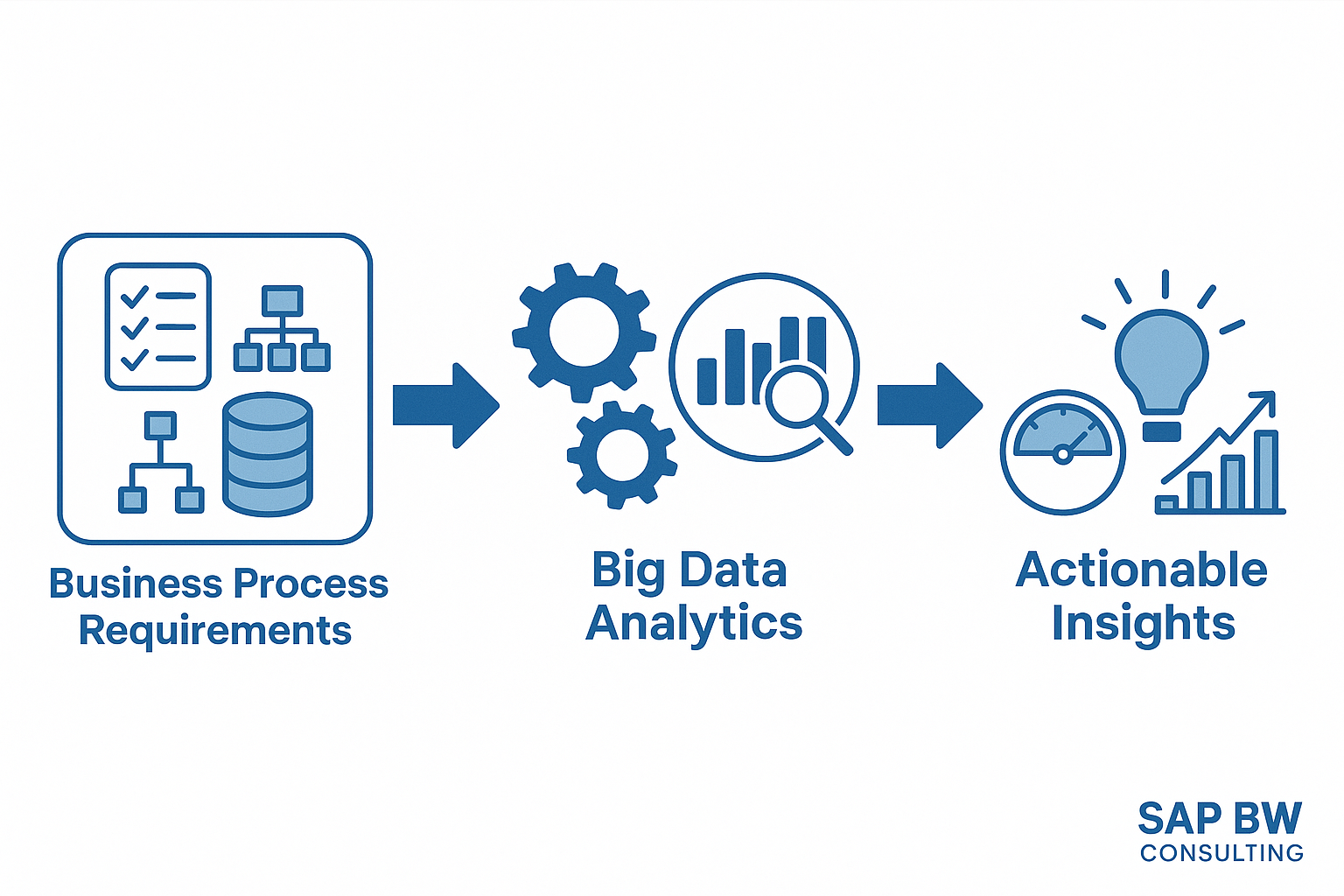
Let's explore the importance of identifying and analyzing business process requirements for leveraging big data. By aligning business process requirements with big data analytics, organizations can extract valuable insights that can be used to optimize critical business processes and gain a competitive edge.
We will also discuss how big data insights can be utilized to make informed decisions and drive strategic initiatives, ultimately leading to enhanced shareholder value and business growth.
Furthermore, we will delve into the various challenges that organizations may face when leveraging big data for business processes. From ensuring data quality and security to building a data-driven culture and infrastructure, we will provide strategies and solutions to overcome these obstacles and maximize the potential of big data analysis.
Looking towards the future, we will explore the emerging trends in leveraging business process requirements for big data analysis. The role of artificial intelligence and machine learning in revolutionizing big data analysis and driving innovation will be discussed, as well as the importance of embracing advanced analytics and predictive modeling for actionable insights.
To unlock the full potential of big data, organizations must grasp and utilize the requirements of their business processes. By doing so, they can gain valuable insights, enhance efficiency, outperform competitors, and achieve business success.
Stay ahead of the curve and embrace the power of big data to propel your organization towards a brighter and more prosperous future.
Understanding Business Process Requirements
In today's data-driven world, the importance of identifying and analyzing business process requirements for leveraging big data cannot be overstated. By understanding the specific needs and goals of a company's business processes, organizations can effectively harness the power of big data to drive strategic decision-making and enhance operational efficiency.
Identifying and analyzing business process requirements is the foundation for unlocking the true potential of big data. It involves understanding the key processes within an organization and identifying the data points that are essential for optimizing those processes. This step is crucial because it allows companies to focus their big data efforts on the areas that will have the greatest impact on their business success.
Once the business process requirements have been identified, organizations can align them with big data analytics to extract valuable insights. By combining the power of advanced analytics tools with the specific needs of the business processes, companies can uncover patterns, trends, and correlations in the data that can inform strategic decision-making. These insights can provide a competitive advantage by enabling companies to make data-driven decisions that optimize their operations and drive business growth.
Furthermore, leveraging big data insights can also enhance shareholder value. By using the actionable insights gained from big data analysis, companies can identify new opportunities, improve customer experiences, and develop innovative products and services. This, in turn, can lead to increased revenue, improved profitability, and ultimately, enhanced shareholder value.
In addition to improving operational efficiency and enhancing shareholder value, leveraging big data for business processes can also help organizations gain a deeper understanding of their customers.
By analyzing customer data, companies can uncover valuable insights about their preferences, behaviors, and needs. This information can then be used to personalize marketing strategies, improve customer experiences, and build stronger customer relationships.
However, it is important to acknowledge the challenges that organizations may face when leveraging big data for business processes. Ensuring data quality and security is a critical concern, as organizations need to ensure that the data they are analyzing is accurate, reliable, and protected. Building a data-driven culture and infrastructure is also crucial, as it requires organizations to invest in the necessary technology, skills, and processes to effectively leverage big data.
Looking towards the future, the role of artificial intelligence (AI) and machine learning (ML) in big data analysis cannot be ignored. These technologies have the potential to revolutionize the way organizations analyze and extract insights from big data.
By leveraging AI and ML algorithms, companies can automate the analysis of vast amounts of data, uncovering patterns and insights that would be impossible for humans to identify. This can lead to faster and more accurate decision-making, as well as the discovery of new opportunities for innovation and growth.
To truly harness the power of big data, organizations must recognize the criticality of identifying and analyzing business process requirements. By aligning these requirements with big data analytics, companies can unlock invaluable insights, enhance operational efficiency, gain a competitive edge, and ultimately achieve business success.
As companies continue to embrace the power of big data, those that prioritize understanding their unique business process requirements will be well-positioned to thrive in the data-driven future.
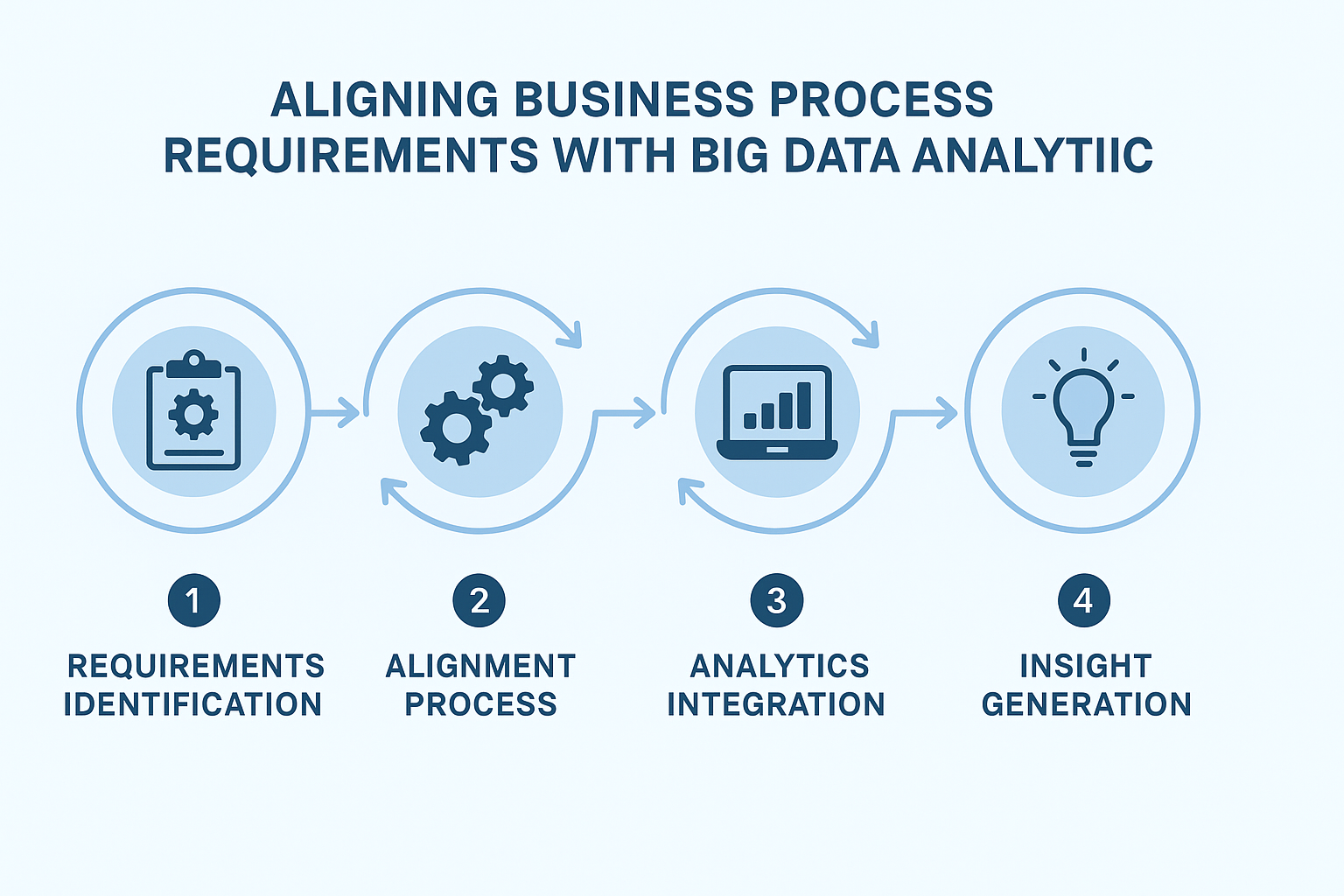
Aligning Business Process Requirements with Big Data Analytics
In today's data-driven world, aligning business process requirements with big data analytics is essential for organizations looking to extract actionable insights.
By understanding the specific needs and goals of a company's business processes, organizations can effectively leverage the power of big data to drive strategic decision-making and enhance operational efficiency.
Aligning business process requirements with big data analytics involves identifying the critical business processes that can be optimized through data analysis. It requires a deep understanding of the key processes within an organization and the data points that are essential for optimizing those processes.
Pro-Tip:
When mapping business process requirements to data analytics, always involve your front-line process owners in initial workshops. Their insights ensure requirements are grounded in real-world operations and prevent costly rework during implementation.
By focusing their big data efforts on these areas, organizations can maximize the impact of their data analysis and uncover valuable insights.
Once business process requirements have been identified, organizations can then align them with big data analytics to extract actionable insights.
By combining the power of advanced analytics tools with the specific needs of the business processes, companies can uncover patterns, trends, and correlations in the data that can inform strategic decision-making. These insights can provide a competitive advantage by enabling companies to make data-driven decisions that optimize their operations and drive business growth.
By aligning business process requirements with big data analytics, organizations can also enhance shareholder value. The actionable insights gained from big data analysis can help companies identify new opportunities, improve customer experiences, and develop innovative products and services. This, in turn, can lead to increased revenue, improved profitability, and ultimately, enhanced shareholder value.
In addition to improving operational efficiency and enhancing shareholder value, aligning business process requirements with big data analytics can also help organizations gain a deeper understanding of their customers.
By analyzing customer data, companies can uncover valuable insights about their preferences, behaviors, and needs. This information can then be used to personalize marketing strategies, improve customer experiences, and build stronger customer relationships.
To achieve actionable insights, organizations must align their business process requirements with big data analytics. By fully understanding the unique needs and goals of their business processes and harnessing the power of big data, organizations can unlock valuable insights, enhance operational efficiency, gain a competitive edge, and drive overall business success.
So, learn how to align your business process requirements with big data analytics and unlock the full potential of your data.
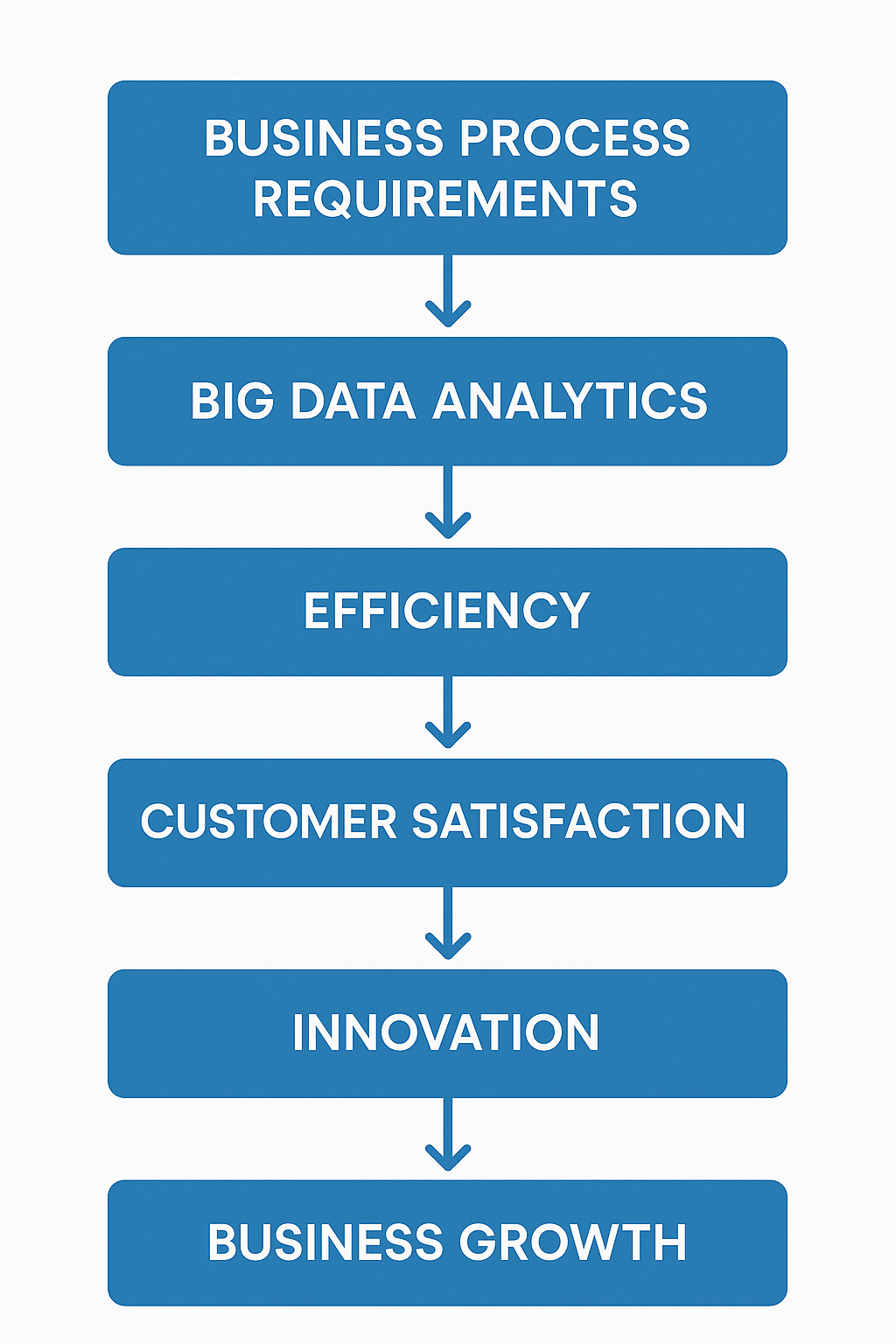
Maximizing Competitive Advantage through Big Data Analysis
Pro-Tip:
Leverage data visualization tools (such as SAP Analytics Cloud or Power BI) to surface emerging trends. Set automated alerts for anomalies—enabling faster decisions and giving your company the agility to capitalize on new opportunities before competitors do.
In today's rapidly evolving business landscape, gaining a competitive edge is crucial for organizations looking to thrive and stay ahead of their competitors.
One powerful tool that can help businesses achieve this is the harnessing of big data analytics. By effectively leveraging the power of big data, companies can not only gain valuable insights but also gain a significant competitive advantage in their respective industries.
Harnessing big data analytics enables organizations to collect, analyze, and interpret vast amounts of data from various sources.
By doing so, businesses can uncover hidden patterns, trends, and correlations that can inform strategic decision-making and drive business success. These insights can provide organizations with a deeper understanding of market trends, customer preferences, and competitor behaviors, allowing them to make data-driven decisions that give them an edge over their rivals.
Furthermore, big data analytics can provide organizations with real-time insights, allowing them to respond quickly to market changes and customer demands.
By having access to up-to-date information, companies can adapt their strategies, products, and services to meet evolving customer needs, giving them a competitive advantage over slower-moving competitors.
In addition, big data analytics can also help organizations identify new opportunities for innovation and growth.
By analyzing large datasets, businesses can uncover niche markets, emerging trends, and potential gaps in the market that their competitors may have overlooked. This allows them to develop innovative products and services that address these opportunities, positioning them as industry leaders and setting them apart from their competitors.
Moreover, by effectively harnessing big data analytics, organizations can improve their operational efficiency and streamline their processes.
By analyzing vast amounts of data, businesses can identify bottlenecks, inefficiencies, and areas for improvement within their operations. This allows them to optimize their processes, reduce costs, and increase productivity, giving them a competitive advantage by delivering products and services more efficiently than their competitors.
Harnessing the potential of big data analytics is a game-changer for organizations, providing them with a distinct advantage in the competitive landscape. By efficiently gathering, analyzing, and deciphering massive amounts of data, businesses can gain invaluable insights, swiftly adapt to market dynamics, unearth novel opportunities, and enhance their operational efficiency.
In today's data-driven world, those organizations that can effectively leverage big data analytics will be well-positioned to outperform their competitors and achieve long-term success. So, embrace the power of big data analytics and gain the competitive advantage you need to thrive in today's business landscape.
Identifying Key Business Processes for Analysis
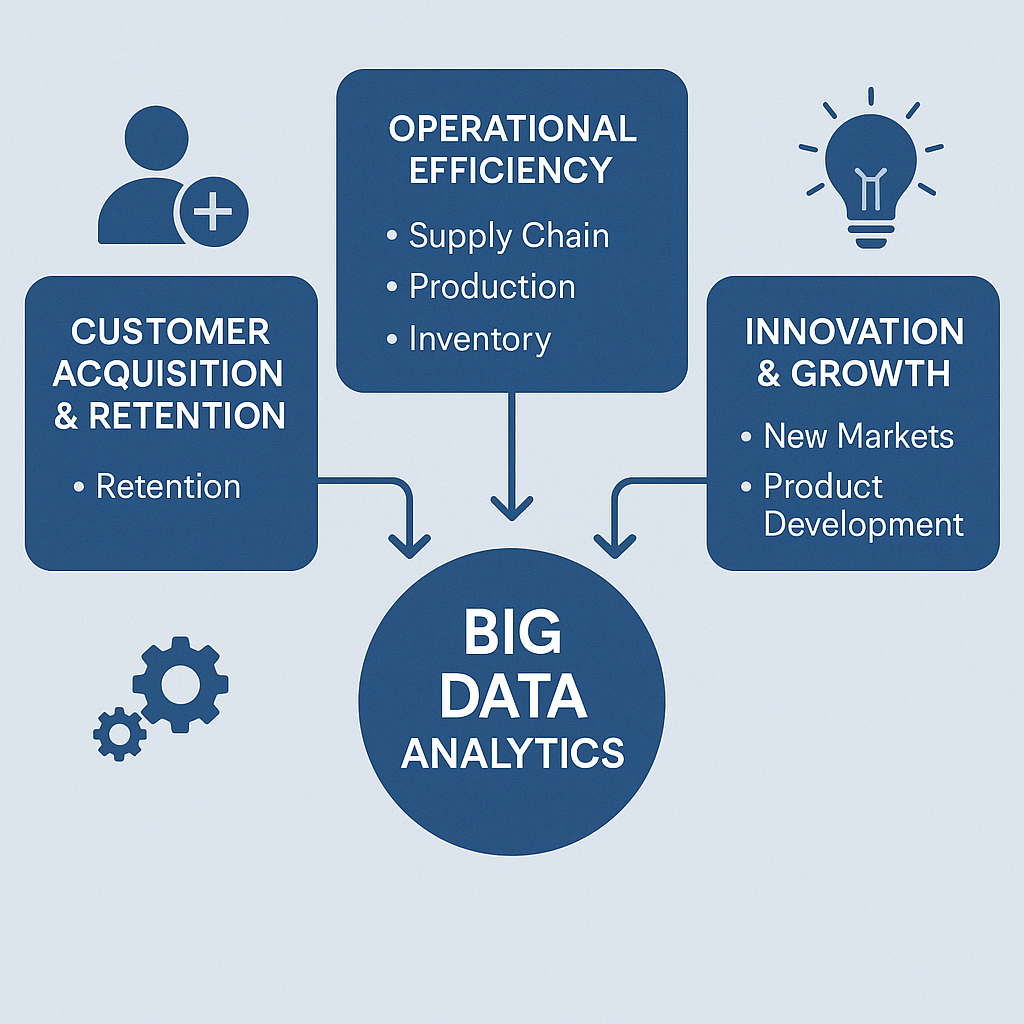
Identifying the critical business processes that can be optimized through big data analysis is a crucial step in leveraging the power of data for organizational success.
By understanding which processes can benefit the most from data analysis, companies can focus their efforts and resources on extracting valuable insights that can drive strategic decision-making and enhance operational efficiency.
To identify the key business processes for analysis, organizations need to conduct a thorough evaluation of their operations.
This involves assessing each process's impact on the overall business objectives, understanding the data points that are essential for optimizing those processes, and determining the potential benefits of using big data analytics.
One approach to identifying critical business processes is to prioritize those that directly impact customer satisfaction and experience.
By analyzing customer data, organizations can gain insights into customer preferences, behaviors, and needs, allowing them to personalize marketing strategies, improve customer experiences, and build stronger customer relationships.
Processes such as customer acquisition, retention, and support can greatly benefit from big data analysis in order to enhance customer satisfaction and loyalty.
Another approach is to identify processes that have a significant impact on operational efficiency and cost optimization.
By analyzing operational data, organizations can uncover inefficiencies, bottlenecks, and areas for improvement within their processes. This can lead to streamlining operations, reducing costs, and increasing productivity.
Processes such as supply chain management, production planning, and inventory management can be optimized through big data analysis to improve overall operational efficiency.
Additionally, organizations can consider focusing on processes that are critical for innovation and growth.
By analyzing market and competitor data, companies can identify emerging trends, niche markets, and potential gaps that their competitors may have overlooked. This can provide valuable insights for developing innovative products and services that address these opportunities, positioning the organization as an industry leader.
To fully harness the potential of data, organizations must prioritize identifying and optimizing critical business processes through big data analysis..
By prioritizing processes that impact customer satisfaction, operational efficiency, and innovation, companies can focus their efforts on extracting valuable insights that can drive strategic decision-making and enhance their competitive advantage.
So, take the time to identify the key business processes for analysis, and unlock the full potential of big data for your organization's success.
Leveraging Big Data Insights for Strategic Decision Making
Discovering how to use big data insights to make informed decisions and drive strategic initiatives is crucial in today's data-driven business landscape.
By effectively leveraging the power of big data analytics, organizations can uncover valuable insights that can inform and guide their decision-making processes.
To begin with, organizations need to have a clear understanding of their data sources and the specific insights they want to gain. This involves identifying the relevant data points and metrics that can provide meaningful insights into their business processes.
By focusing on the right data, organizations can ensure that they are extracting the most relevant and actionable insights.
Once the data sources and metrics have been identified, organizations can then use advanced analytics tools and techniques to analyze the data and uncover valuable insights.
These tools can help organizations identify patterns, trends, and correlations in the data that may not be immediately apparent. By uncovering these insights, organizations can make more informed decisions that are grounded in data and evidence.
Furthermore, organizations can also use big data insights to drive strategic initiatives.
For example, by analyzing customer data, organizations can gain a deeper understanding of their customers' preferences, behaviors, and needs. This information can then be used to develop targeted marketing strategies, personalized product offerings, and enhanced customer experiences.
By aligning their strategic initiatives with the insights gained from big data analysis, organizations can increase their chances of success and achieve their business goals.
To thrive in today's data-driven business landscape, organizations must understand how to harness the power of big data insights to drive informed decisions and strategic initiatives.
By leveraging the power of big data analytics, organizations can uncover valuable insights that can inform their decision-making processes and guide their strategic initiatives.
So, take the time to understand your data sources, identify relevant metrics, and use advanced analytics tools to uncover actionable insights that can drive your organization's success.
Enhancing Shareholder Value with Big Data-driven Solutions
In today's fast-paced and highly competitive business landscape, driving shareholder value and achieving business growth are top priorities for organizations. And one powerful tool that can help achieve these goals is big data analytics.
Big data analytics offers organizations a unique opportunity to uncover valuable insights and make data-driven decisions that can enhance shareholder value and drive business growth.
By effectively leveraging the power of big data, companies can gain a deeper understanding of their market, customers, and competitors, allowing them to make strategic decisions that maximize shareholder value.
One way big data can drive shareholder value is by providing organizations with a comprehensive view of their market.
By analyzing large datasets, businesses can identify emerging trends, changing customer preferences, and potential gaps in the market. This information can be used to develop innovative products and services that meet these evolving market needs, positioning the organization as an industry leader and increasing shareholder value.
Additionally, big data analytics can help organizations optimize their operations and improve efficiency.
By analyzing operational data, businesses can identify bottlenecks, inefficiencies, and areas for improvement within their processes. This can lead to cost reductions, increased productivity, and improved operational efficiency, all of which contribute to higher shareholder value.
Furthermore, big data analytics can provide organizations with valuable insights into customer behavior and preferences.
By analyzing customer data, businesses can personalize their marketing strategies, enhance customer experiences, and build stronger customer relationships. This can lead to increased customer loyalty, higher customer satisfaction, and ultimately, increased shareholder value.
Moreover, big data analytics can also help organizations identify new business opportunities.
By analyzing market data and competitor behavior, companies can uncover niche markets, emerging trends, and potential gaps that their competitors may have overlooked. This allows them to develop new products and services that address these opportunities, positioning the organization for growth and increasing shareholder value.
In summary, the power of big data to enhance shareholder value and drive business growth is truly remarkable.
By effectively leveraging big data analytics, organizations can gain valuable insights, optimize their operations, and identify new business opportunities. This not only enhances shareholder value but also positions the organization for long-term success in today's data-driven business landscape.
So, embrace the power of big data and unlock its potential to drive shareholder value and business growth.
Utilizing Big Data to Improve Operational Efficiency
Pro-Tip:
Use predictive analytics to forecast demand spikes and bottlenecks in advance. Review these forecasts weekly and adjust supply chain resources proactively to minimize unplanned downtime and excess inventory costs.
Big data has become a game-changer for organizations looking to improve their operational efficiency. By harnessing the power of data analysis, companies can streamline their operations and increase efficiency in various ways.
One way big data can be utilized to streamline operations is through predictive analytics.
By analyzing historical data and patterns, organizations can predict future demand for their products or services, allowing them to optimize their production and supply chain processes. This not only ensures that the right amount of inventory is available at the right time but also minimizes wastage and reduces costs.
Another way big data can improve operational efficiency is through real-time monitoring and analytics. By collecting and analyzing data in real-time, organizations can quickly identify any bottlenecks or inefficiencies in their processes.
For example, in a manufacturing setting, real-time data analysis can help identify machine breakdowns or maintenance needs, allowing for timely repairs and minimizing downtime.
Furthermore, big data analytics can also be used to automate and optimize processes.
By analyzing large volumes of data, organizations can identify repetitive tasks or manual processes that can be automated. This not only saves time and reduces the risk of human error but also frees up employees to focus on more value-added activities.
Moreover, big data can be used to enhance collaboration and communication within an organization.
By analyzing data from various sources, organizations can gain insights into how different departments or teams are performing and identify any communication or collaboration gaps. This can help streamline workflows, improve coordination, and ultimately increase operational efficiency.
In summary, the power of big data to transform and optimize organizational operations is truly remarkable.
By leveraging the power of data analysis, organizations can make informed decisions, automate processes, and optimize workflows. This not only improves operational efficiency but also enhances overall productivity and drives business growth.
So, embrace the power of big data and unlock its potential to streamline operations and increase efficiency in your organization.
Leveraging Big Data for Customer Insights and Personalization
Pro-Tip:
Start with quick-win personalization: segment customers by behavior, then customize outbound emails and site recommendations. Even basic personalization can deliver double-digit improvements in engagement and sales.
In today's competitive business landscape, gaining valuable customer insights and delivering personalized experiences are crucial for organizations to stay ahead.
By leveraging the power of big data, companies can unlock a wealth of information that can help them understand their customers better and create tailored experiences that meet their needs and preferences.
Using big data analytics, organizations can analyze vast amounts of customer data to uncover patterns, trends, and behaviors. This data can provide valuable insights into customer preferences, buying habits, and even their sentiment towards the brand.
By understanding these insights, companies can make informed decisions on product development, marketing strategies, and customer service initiatives.
For example, by analyzing customer data, organizations can identify which products or services are most popular among certain demographics or customer segments. This information can then be used to create personalized recommendations and targeted marketing campaigns, increasing the likelihood of customer engagement and loyalty.
Furthermore, big data can also be used to deliver personalized experiences to customers.
By analyzing data on customer preferences, past purchases, and browsing behavior, organizations can create customized offers, discounts, and promotions that are tailored to each individual customer. This level of personalization not only enhances the customer experience but also increases the chances of repeat purchases and brand loyalty.
To thrive in today's customer-centric business landscape, organizations must harness the power of big data to unlock valuable customer insights and provide personalized experiences. This is a crucial aspect of success in the modern business world.
By analyzing customer data and using it to inform decision-making and personalize interactions, companies can create meaningful connections with their customers and drive business growth.
So, embrace the power of big data and unlock its potential to gain customer insights and deliver personalized experiences that set your organization apart from the competition.
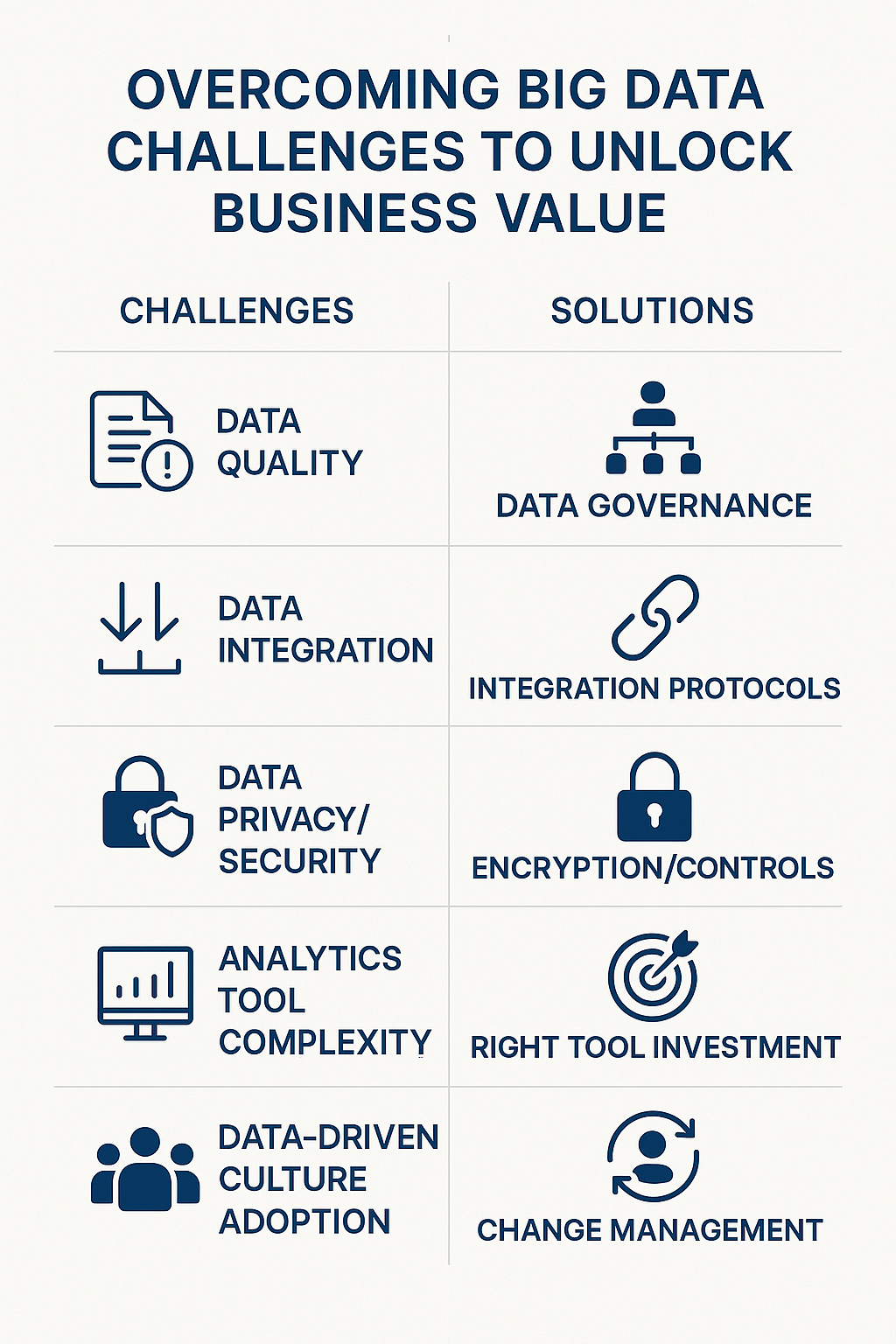
Overcoming Challenges in Leveraging Big Data for Business Processes
Pro-Tip:
Document your most common data quality or integration problems as simple ‘FAQ’ or ‘Playbook’ entries. Share these with new project team members to accelerate onboarding and reduce recurring mistakes.
Navigating the obstacles and overcoming challenges in effectively leveraging big data for business processes is crucial for organizations to reap the benefits of data-driven decision-making.
While big data analytics presents immense opportunities, it also comes with its fair share of challenges that need to be addressed.
One of the key challenges in leveraging big data is data quality and reliability.
With large volumes of data being generated from various sources, ensuring the accuracy, completeness, and consistency of the data can be a daunting task.
Organizations need to invest in data governance and data quality management practices to establish reliable data sources and ensure the integrity of the data being analyzed.
Another challenge is data integration and interoperability.
Organizations often have data scattered across different systems and platforms, making it difficult to consolidate and analyze the data comprehensively.
Implementing robust data integration solutions and adopting standardized formats and protocols can help overcome this challenge and enable seamless data analysis across the organization.
Data privacy and security is another critical challenge in leveraging big data.
With the increasing concerns around data breaches and privacy regulations, organizations need to prioritize data protection measures. Implementing robust data security protocols, complying with relevant privacy regulations, and ensuring the ethical use of customer data are essential steps in overcoming this challenge.
Furthermore, the complexity and scalability of big data analytics tools can be a hurdle for organizations.
Implementing and managing sophisticated analytics platforms and tools require technical expertise and significant investments. Organizations need to carefully evaluate their analytics requirements, choose the right tools, and invest in training and development to build the necessary capabilities.
Lastly, organizational culture and change management can also pose challenges in effectively leveraging big data.
Embracing a data-driven culture and encouraging data-driven decision-making requires a shift in mindset and organizational practices. Organizations need to invest in change management initiatives, provide training and support to employees, and foster a culture that values data-driven insights.
Despite these challenges, organizations can overcome them by adopting a holistic approach to big data analytics.
This includes investing in data governance practices, ensuring data quality and reliability, implementing robust data integration and security measures, leveraging scalable analytics tools, and fostering a data-driven culture.
By navigating these obstacles and overcoming challenges, organizations can unlock the full potential of big data analytics and drive business growth and success in today's data-driven business landscape.
Ensuring Data Quality and Security
Ensuring data quality and security is essential when leveraging big data for business processes.
As organizations collect and analyze large volumes of data, it is crucial to implement strategies that guarantee the accuracy, reliability, and integrity of the data being used.
One strategy to ensure data quality is to establish robust data governance practices. This involves creating policies and procedures for data management, defining data ownership, and establishing data quality standards.
By implementing data governance, organizations can ensure that data is collected, stored, and analyzed in a consistent and standardized manner.
Another important aspect of ensuring data quality is data validation and cleansing. This involves conducting regular checks and audits to identify and correct any errors, inconsistencies, or duplications in the data.
By cleaning and validating the data, organizations can improve its accuracy and reliability, ultimately leading to more reliable insights and decision-making.
In addition to data quality, organizations must also prioritize data security when leveraging big data. With the increasing concerns around data breaches and privacy regulations, it is crucial to implement robust data security measures.
One strategy for data security is to encrypt sensitive data.
Encryption ensures that data is transformed into a code that can only be accessed with the appropriate decryption key. By encrypting data, organizations can protect it from unauthorized access and mitigate the risk of data breaches.
Furthermore, organizations should also implement access controls and authentication mechanisms to ensure that only authorized personnel can access and manipulate the data. This can be done through the use of strong passwords, multi-factor authentication, and role-based access controls.
Regular monitoring and auditing of data access and usage is also crucial for data security. By monitoring data activity, organizations can quickly identify any suspicious or unauthorized behavior and take immediate action to mitigate any potential threats.
Lastly, organizations should also prioritize employee training and awareness programs to educate staff about data security best practices. This includes training employees on how to handle and protect sensitive data, as well as raising awareness about the importance of data security and the potential risks associated with data breaches.
To summarize, prioritizing data quality and security is paramount when harnessing the potential of big data for business processes.
By implementing strategies such as data governance, validation and cleansing, encryption, access controls, monitoring, and employee training, organizations can mitigate the risks associated with data analysis and ensure the integrity and security of their data.
Building a Data-driven Culture and Infrastructure
Creating a data-driven culture and building the necessary infrastructure are essential steps for organizations looking to successfully leverage big data initiatives.
To create a data-driven culture, organizations need to start by fostering a mindset of data-driven decision-making at all levels of the organization.
This involves educating employees about the value and importance of data, and encouraging them to use data in their day-to-day work. Training programs can be implemented to enhance data literacy and analytical skills among employees, ensuring that they have the necessary knowledge and tools to effectively analyze and interpret data.
In addition to training, organizations should also establish clear goals and objectives for their data initiatives.
By setting measurable targets and aligning them with the overall business strategy, organizations can ensure that their data-driven efforts are focused and impactful.
Regularly tracking and evaluating progress towards these goals will help keep the organization accountable and drive continuous improvement.
Building the necessary infrastructure to support big data initiatives involves investing in the right technology and resources.
Organizations should assess their data storage and processing needs and invest in scalable infrastructure that can handle large volumes of data. Cloud-based solutions can be particularly beneficial, as they offer flexibility, scalability, and cost-efficiency.
Alongside infrastructure, organizations need to implement robust data governance practices to ensure the quality and integrity of their data.
This involves establishing data management policies, defining data ownership and accountability, and implementing data quality standards. By standardizing data collection, storage, and analysis processes, organizations can minimize errors, inconsistencies, and duplication of data.
Furthermore, organizations should prioritize data security and privacy when building their infrastructure.
This includes implementing robust cybersecurity measures, such as encryption, access controls, and regular monitoring, to protect sensitive data from unauthorized access and breaches. Compliance with relevant privacy regulations is also crucial to ensure the ethical and legal use of customer data.
To sustain a data-driven culture and infrastructure, organizations should regularly evaluate and update their practices.
This includes staying informed about emerging technologies and trends in big data analytics, as well as continuously monitoring and improving data quality, security, and governance processes. By embracing a culture of continuous learning and improvement, organizations can stay ahead in the rapidly evolving field of big data.
To sum up, establishing a culture that embraces the power of data and developing the essential infrastructure are crucial for organizations to effectively utilize the potential of big data initiatives.
By fostering a data-driven mindset, setting clear goals, investing in scalable technology, implementing robust data governance practices, and prioritizing data security and privacy, organizations can unlock the full potential of big data and drive business growth and success.
Future Trends in Leveraging Business Process Requirements for Big Data Analysis
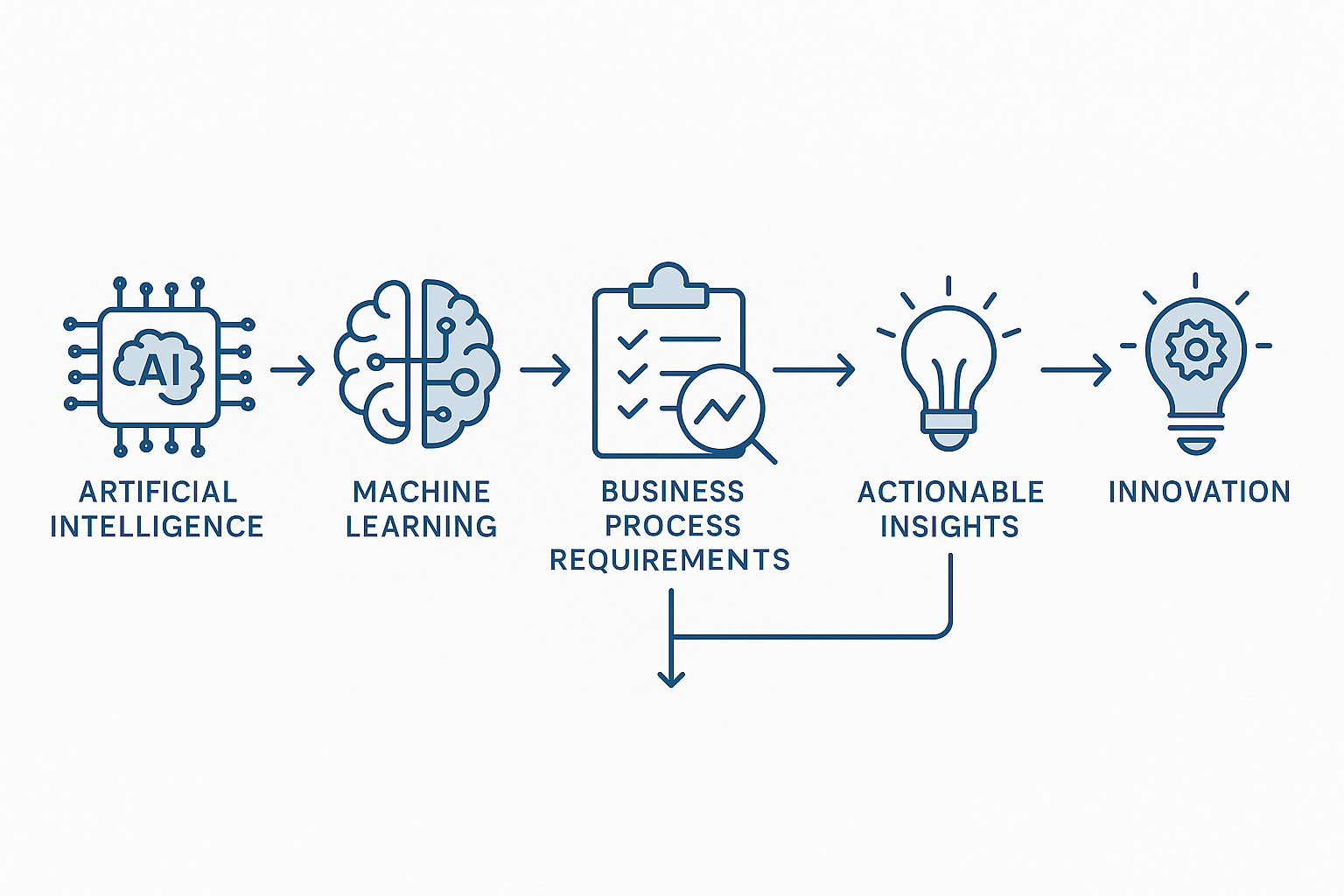
The future of leveraging business process requirements for big data analysis is poised to bring about significant advancements and opportunities for organizations. As technology continues to evolve at a rapid pace, so too does the potential for extracting valuable insights from big data.
One of the key future trends in this field is the integration of artificial intelligence (AI) and machine learning (ML) algorithms into the big data analysis process.
AI and ML technologies have the ability to analyze vast amounts of data in real-time, identifying patterns and trends that may not be apparent to human analysts. By leveraging these technologies, organizations can gain deeper and more accurate insights from their data, enabling them to make more informed decisions and drive business growth.
Another future trend is the increasing use of predictive analytics in big data analysis. Predictive analytics involves using historical data to make predictions about future events or outcomes.
By analyzing patterns and trends in the data, organizations can identify potential future scenarios and develop strategies to capitalize on them. This can be particularly valuable in industries such as finance, marketing, and supply chain management, where accurate forecasting can lead to significant competitive advantages.
Furthermore, the future of big data analysis will likely involve the integration of data from a variety of sources, including social media, IoT devices, and external databases.
As the Internet of Things (IoT) continues to expand, organizations will have access to a wealth of real-time data that can provide valuable insights into customer behavior, market trends, and operational efficiency. By harnessing this data and integrating it with their existing datasets, organizations can gain a more comprehensive and holistic view of their business and make data-driven decisions with greater confidence.
In addition, the future of leveraging business process requirements for big data analysis will also involve the use of advanced data visualization techniques. Data visualization allows organizations to present complex data in a visual and intuitive format, making it easier for stakeholders to understand and interpret.
By using interactive charts, graphs, and dashboards, organizations can uncover hidden patterns and insights in their data, facilitating better decision-making and communication across the organization.
To sum up, the future of harnessing business process requirements for big data analysis is filled with immense potential and exciting possibilities. With the continuous advancements in AI and ML, the power of predictive analytics, seamless data integration, and visually appealing data visualization techniques, organizations will be equipped with the necessary tools and capabilities to unlock valuable insights from their data and pave the way for unparalleled business success.
By staying ahead of these trends and embracing new technologies, organizations can position themselves as leaders in their industries and capitalize on the power of big data.
The Role of Artificial Intelligence and Machine Learning in Big Data Analysis
AI and machine learning are revolutionizing big data analysis and driving innovation in numerous industries.
These technologies have the capability to process and analyze massive amounts of data at an unprecedented speed, enabling organizations to uncover valuable insights and make data-driven decisions.
One area where AI and machine learning are making a significant impact is in predictive analytics. By training algorithms on historical data, organizations can use these technologies to forecast future trends and outcomes.
For example, in the finance industry, AI algorithms can analyze market data and historical trading patterns to predict stock market movements and make informed investment decisions. In the healthcare industry, machine learning algorithms can analyze patient data to identify patterns that can help predict disease outcomes and guide treatment plans.
Another area where AI and machine learning are driving innovation is in natural language processing (NLP) and sentiment analysis.
These technologies can analyze vast amounts of text data, such as customer reviews, social media posts, and news articles, to understand and extract insights from human language. Organizations can use this information to gain a deeper understanding of customer sentiment, identify emerging trends, and improve their products and services accordingly.
In addition, AI and machine learning algorithms are being used to automate and optimize business processes.
By analyzing data from various sources, these technologies can identify inefficiencies, bottlenecks, and areas for improvement in workflows and operations. This allows organizations to streamline their processes, reduce costs, and improve overall efficiency.
Furthermore, AI and machine learning are driving innovation in anomaly detection and cybersecurity. These technologies can analyze network traffic, user behavior, and system logs to identify unusual patterns or activities that may indicate a security threat.
By detecting and responding to these anomalies in real-time, organizations can mitigate the risk of data breaches and protect sensitive information.
Overall, AI and machine learning are revolutionizing big data analysis by enabling organizations to extract valuable insights, predict future trends, automate processes, and enhance cybersecurity.
As these technologies continue to advance, the possibilities for innovation and growth in the field of big data analysis are limitless. Organizations that embrace and leverage AI and machine learning will be at the forefront of driving business success in the digital age.
Embracing Advanced Analytics and Predictive Modeling for Actionable Insights
Advanced analytics and predictive modeling are revolutionizing the way organizations extract insights from their data.
By leveraging emerging technologies and techniques, organizations can uncover actionable insights that drive business growth and success.
One of the emerging technologies in advanced analytics is natural language processing (NLP). NLP enables organizations to analyze and understand human language, such as customer reviews, social media posts, and news articles.
By applying NLP techniques, organizations can gain a deeper understanding of customer sentiment, identify emerging trends, and make data-driven decisions to improve their products and services.
Another emerging technology is machine learning. Machine learning algorithms can analyze vast amounts of data and identify patterns and trends that may not be apparent to human analysts.
By leveraging machine learning, organizations can make more accurate predictions and forecasts, enabling them to optimize business processes, reduce costs, and improve overall efficiency.
In addition to these emerging technologies, organizations can also leverage techniques such as data mining and statistical modeling to gain actionable insights from their data.
Data mining involves exploring and analyzing large datasets to identify patterns, correlations, and anomalies. Statistical modeling, on the other hand, allows organizations to make predictions and forecasts based on historical data.
By embracing advanced analytics and predictive modeling, organizations can unlock the full potential of their data and make data-driven decisions with confidence. These techniques enable organizations to identify opportunities, mitigate risks, and optimize their operations for maximum efficiency and profitability.
Final Thoughts
In conclusion, exploring emerging technologies and techniques in advanced analytics and predictive modeling is crucial for organizations seeking actionable insights from their data. By staying ahead of the curve and leveraging these tools, organizations can drive business growth, stay competitive, and achieve long-term success in the era of big data.


